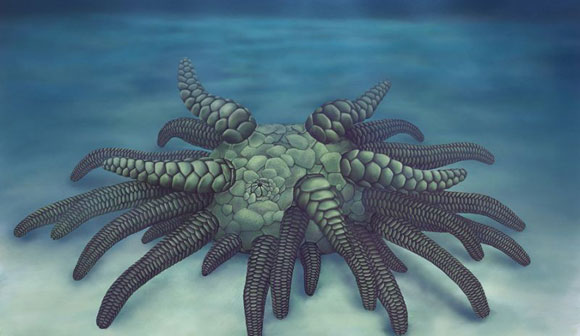Scientists Identify Ancient “Monster” from the Deep
Tentacled “Cthulhu” Fossil Reveals Relative of Modern Sea Cucumbers
The remarkable Silurian-aged deposits located at a secret site in Herefordshire (England), have provided scientists with a unique look at the early evolution of sea cucumbers and their relatives. The rocks at this location are comprised of very fine grained volcanic ash that settled on the seafloor some 430 to 425 million years ago. These deposits have preserved in fantastic detail the remains of the marine biota. The latest new species to be named from this location is Sollasina cthulhu, a multi-tentacled, benthic animal that was a ferocious predator.
The prehistoric sea cucumber’s trivial name honours the “Cthulhu” universe, as it resembles some of the monsters created by the American, 20th century science-fiction writer H. P. Lovecraft. At only three centimetres across, it might not look very formidable to us, but its numerous tentacles, (actually tube feet), would have been used to terrorise and capture other animals as it roamed across the seafloor.
A Life Reconstruction of the Newly Described Sollasina cthulhu
Picture credit: Elissa Martin, (Yale Peabody Museum of Natural History)
Writing in the academic journal the “Proceedings of the Royal Society B (Biology)”, palaeontologists from the USA and the UK were able to create an accurate, three-dimensional digital reconstruction of the 430-million-year-old fossil. The exceptionally preserved fossil, once analysed using this three-dimensional computer modelling technique, revealed details of internal soft tissues previously not seen in a fossil like this.
Sollasina cthulhu
Like other fossils from the secret Herefordshire “Lagerstätte”, Sollasina cthulhu was examined using a method that involved grinding it away, layer-by-layer, with a photograph taken at each stage. This led to hundreds of images being produced which were then combined in a special computer programme to create an exact 3-D image, a “virtual fossil”.
The scientists, which included researchers from the Oxford Museum of Natural History, Leicester University, Imperial College London, Yale University and the University of Southern California, were able to make out an internal ring, which is believed to be part of the organism’s water vascular system. The water vascular system is the system of fluid-filled canals used for feeding and movement in living sea cucumbers and their relatives.
Dr Imran Rahman (Deputy Head of Research at Oxford University Museum of Natural History) and lead author of the paper stated:
“Sollasina belongs to an extinct group called the ophiocistioids, and this new material provides the first information on the group’s internal structures. This includes an inner ring-like form that has never been described in the group before. We interpret this as the first evidence of the soft parts of the water vascular system in ophiocistioids.”
Computer-based Analysis
This new fossil was subjected to a phylogenetic analysis to assess the evolutionary relationships between fossil sea cucumbers and sea urchins (members of the Echinodermata Phylum). The results showed that Sollasina and its relatives are more closely related to sea cucumbers than they are to sea urchins. This has provided a new insight into the evolution of this very important group of invertebrates.
A Computer-generated Three-dimensional Image of Sollasina cthulhu

Picture credit: Dr Imran Rahman (Oxford University Museum of Natural History)
Dr Jeffrey Thompson (University of Southern California) and a co-author of the paper commented:
“We carried out a number of analyses to work out whether Sollasina was more closely related to sea cucumbers or sea urchins. To our surprise, the results suggest it was an
ancient sea cucumber. This helps us understand the changes that occurred during the early evolution of the group, which ultimately gave rise to the slug-like forms we see today.”
The Herefordshire site has provided palaeontologists with some remarkable fossils to study:
An ancient Silurian ostracod: An Ancient Ostracod from Herefordshire.
A rare Silurian marine worm: Rare Silurian Fossil Worm from a Herefordshire “Hotspot”.
A Prehistoric Scene – Life in the Silurian Seas

Picture credit: Everything Dinosaur
Everything Dinosaur acknowledges the assistance of a press release from the Oxford University Museum of Natural History in the compilation of this article.
The scientific paper: “A New Ophiocistioid with Soft-tissue Preservation from the Silurian Herefordshire Lagerstätte, and the Evolution of the Holothurian Body Plan” by Imran A. Rahman, Jeffrey R. Thompson, Derek E. G. Briggs, David J. Siveter, Derek J. Siveter and Mark D. Sutton published in the Proceedings of the Royal Society B.
Visit the Everything Dinosaur website: Everything Dinosaur.


